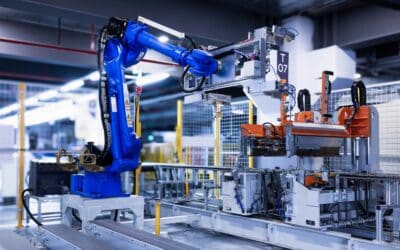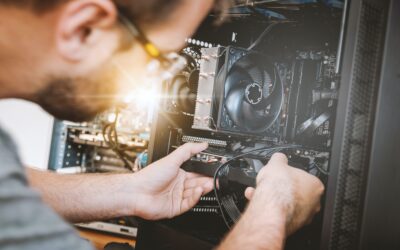The use of robots has long made our everyday lives easier. Companies worldwide use more than 2.7 million industrial robots. They work quickly, take on tasks that seem too monotonous for us, or perform processes that are too dangerous for humans. However, industrial robots can pose a major risk for us. As various accident reports show, they can even be deadly.
Cobots as problem solvers
The solution to this problem is provided by so-called cobots. A cobot is a robot which, due to its technology, can work hand in hand with humans in a collaborative application without being physically separated from humans by fences or other safety precautions. Therefore, the working area of cobot and human overlaps completely. This is also referred to as human-robot collaboration (HRC). Cobots complement and support tasks in the production process, but do not replace them. The advantages of a robot remain and are supplemented not only by the safety factor.
Between humans and machines
Safety
This is also the most important distinguishing feature of a cobot: safety. Closely followed by flexibility. A cobot must be able to stop its executions without any problems should a human move into its orbit. ISO/TS 15066 specifies the standard for when a person is injured. If humans and machines work together without physical boundaries or other safety measures, the communication between the parties must always be correct. To do this, cobots have various sensors that detect at an early stage whether a human or another object is in the way. For example, some cobots communicate using light signals that indicate to humans the robot’s next direction of movement.
Flexibility
In the production process, humans and cobots have one thing in common: they can easily be deployed at a new work location after a short training period. This is because cobots are easy to handle and very flexible. Users can assign them new tasks at any time without prior programming. To do this, the human shows the cobot the new sequence a few times, which the cobot stores and can recall in the future at the push of a button. For instance, some cobots are mobile because they are equipped with wheels. Thus, you can move them quickly from one place to another.
Integrated cloud solution
Cobots can use clouds to independently document, check and optimize the results of their work. In this way, they enable additional time-saving work. In fact, it is no longer necessary to be on site to analyze the results of the cobot work. All that is needed is a protected dashboard inside the browser.
Weight and payload
What also makes working with a cobot easier is their significantly lower weight compared to other industrial robots and machines. However, this weight also determines their payload: the more a cobot weighs, the more it can carry. For example, if a cobot weighs only 4 kg, it can lift only 500 g. Nonetheless, a standard cobot can carry up to 15 kg, about the same as an e-bike.
As demand for increasingly flexibility has grown in recent years, larger models with higher payloads and ranges are now entering the market.
Low cost
The great popularity of a cobot can also be explained by the fact that they bring enormous added value – precisely because of their low cost compared to industrial robots. The price range starts at around 5,000 euros. However, the price depends on other criteria: a cobot that is exposed to unusual temperatures and still has to achieve a high payload, range and speed is significantly more expensive. Again, the guiding principle is ‘you get what you pay for’.
Advantages of HRC
Partially automating certain work processes with cobots combines the advantages of humans and machines. Thus, it is possible to produce situationally, flexibly and adaptably on the one hand and to perform fast, detailed and monotonous tasks on the other hand.
From the assembly line to the operating room
Cobots can be used in all areas with repetitive tasks such as pick and place. With its features, the cobot is already being used in many production halls:
- in assembly,
- welding,
- packaging,
- testing,
- gluing and so on.
In the future, cobots will be used in probably every imaginable area. Examples are already known from medical technology or in the care sector. At the moment, cobots that can be used in the kitchen are also being developed. AI and deep learning play a role here. In Seattle, such a cobot is already being tested in a standard (IKEA) kitchen.
How the cobot prevents collisions
To reliably prevent a collision with a human, appropriate technology is required. This technology is versatile, but also complex. Not every cobot uses the same technology. Depending on the application, different methods take over the HRC. Sensors and protective skin play a major role.
Force sensors
A frequently used version is based on force sensors located inside the base. These detect an external force. The exact load is taken into account. The external force exerted must therefore be greater than the load. So, if a human comes into contact with a cobot and thus performs movements that do not fit the programmed motion profile, the cobot notices it.
Torque sensors
In the same way, it is possible to measure these external forces at any other hinge of the cobot with the help of a torque sensor. As before, the cobot stops in case of contact exceeding the payload.
Protective skin
In rare cases, cobots also have a kind of protective skin, which is equipped with several force points. At a certain force by touch, the cobot stops. It is programmed how much external force may be applied to the individual points. Therefore, Light touches are possible – but usually not painful collisions.
It is obvious that cobots that are only light in weight can hurt humans to a limited extent. It is questionable whether we can speak of a further method of collaboration in this context.
Is the use of a cobot worthwhile for my company?
Relief for employees
Today manual pick and place is still performed by a large number of workers around the world. With the use of cobots, employees can devote themselves to more demanding tasks instead of continuing to work monotonously. In addition, workers are physically relieved. Back pain and other signs of fatigue decrease. The introduction of this technical support has many advantages and therefore not only provides added value for the employees.
Change issues
What you have to reckon with, however, is an initial aversion to the new introduction. This problem is well known in change management. People are creatures of habit, which is why it can be hard to get comfortable with new things. Yet change is essential for businesses. There are specific methods for a better reception of the new features.
Cobots vs industrial robots
The use of cobots also helps to complete work processes faster than without. Nevertheless, cobots are usually slower than industrial robots. It is therefore important to assess in advance whether a cobot is really more worthwhile than purchasing a regular industrial robot. In doing so, one must consider the costs involved. Not only does an industrial robot cost more, but it also requires a costly safety zone.
By overlapping the workspace of humans and cobots, this collaboration does not require additional space for safety measures. Fences or grids are no longer necessary. As a result, companies can work even more flexibly and save space in their production halls.
Into the future with cobots
The first cobot was developed as early as 1996, but it was not until 2008 that Universal Robots sold it for the first time. In recent years, demand for cobots has grown rapidly – but the process is still in the fledgling stage.
The popularity of cobots is therefore increasing – likewise their areas of application. Especially in industry, cobots have become indispensable. Whether in nursing or in the operating room, we will continue to work more and more closely with cobots in the future. R2D2 and Co. could thus become our new work colleagues of tomorrow.



